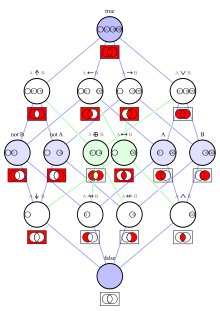Soft properties of Boolean functions
| Studies of Boolean functions |
| ||||
The number of Boolean functions with arity (short for adicity ) is (![]() A001146).
A001146).
This article is about properties of finite truth tables of Boolean functions, that change with the arity.
simple
[edit | edit source]- weight: number of true places
- sharpness: weight parity sharp: odd weight blunt: even weight
subsets
[edit | edit source]
equivalence classes based on similarity
[edit | edit source]see also: Extended families and clans of Boolean functions
ultra (extension with half-complement)
[edit | edit source]|
The two families on the left form a super-family. | ||

|

| |

|

|

|
Each Boolean function has two half-complements. (The truth table is complemented on the left or on the right side.)
A super-family has a unique half-complement. Merging them gives an ultra-family.
As super-clans consist of super-families, they can be extended in the same way.
(Factions do not have a unique half-complement, so it does not seem useful to define ultra-factions.)
ultra-family (negation, complement, half-complement)
[edit | edit source]The functions in an ultra-family have symmetric positions in a hypercube graph (or the related matrix). See matrices.
This family is a complete ultra-family: 1100 1010 (better seen in its matrix)
ultra-clan (negation, permutation, complement, half-complement)
[edit | edit source]An ultra-clan is the merge of a super-clan and its half-complement.
It can also be seen as a merge of ultra-families, that are permutations of each other.
See here for a table of the 39 ultra-families of 4-ary Boolean functions.
partitions into blocks of equal size
[edit | edit source]consul (binary Walsh spectrum)
[edit | edit source]The Walsh spectrum of a TT is its product with a Walsh matrix.
The binary Walsh spectrum of a TT is its product with a binary Walsh matrix, using F2 operations (mod 2).
It is always a Walsh function, and shall be called consul. The term is also used for the integer denoting the Walsh function.
The consul integer is the Walsh index of the prefect of the twin. The consul is essentially the prefect of the twin, but without the negation.
(One could also define a sign for the consul, by using a negated binary Walsh matrix. But the sign would just be the sharpness.)
 |
 (compare 4-ary family with consul 6) |
| 3-ary families with Walsh spectra (integers) and consuls (red backgrounds on the right) | |
| tribe | ||||||||||||||||||||||||||||||||||||||||
|---|---|---|---|---|---|---|---|---|---|---|---|---|---|---|---|---|---|---|---|---|---|---|---|---|---|---|---|---|---|---|---|---|---|---|---|---|---|---|---|---|
|
The consul weight is the binary weight of the consul integer. (E.g. consul 6 has consul weight 2.)
| ||||||||||||||||||||||||||||||||||||||||
3-ary_Boolean_functions#Walsh spectrum, 4-ary_Boolean_functions#wec
patron
[edit | edit source]The patron of a truth table is the XOR of itself and its twin. It is a noble. (3-ary images)
praetor
[edit | edit source]XOR of left and right half of the TT. (3-ary images)
quaestor
[edit | edit source]XOR of left and reversed right half of the truth table (i.e. of the coordinates in the Hasse matrix) (3-ary images)
principalities and dominions
[edit | edit source]A principality is a set of n-ary truth tables whose (n+1)-ary noble equivalents form a faction. Dominions are closely related.





